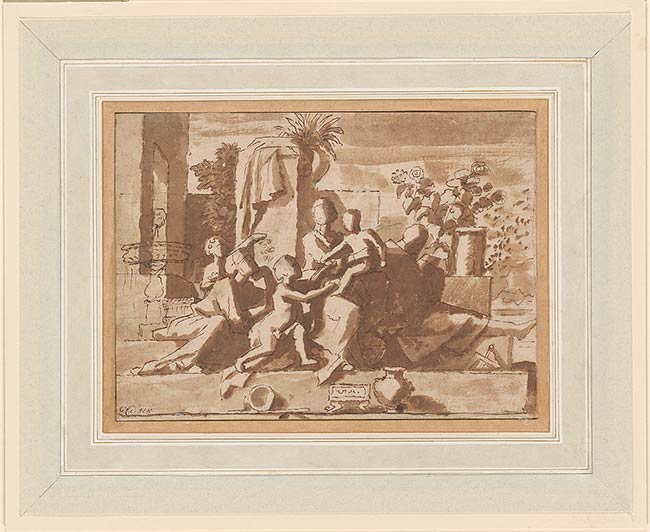
Between 1646 and 1655, Poussin explored the subject of the Holy Family with St. Elizabeth and John the Baptist in numerous drawings and paintings. Diane De Grazia has characterized the process as “really one single thought spread among different canvases over a relatively short period.” It is through such a series of explanations that Poussin's methodical and focused approach to the ideal format for a subject is revealed. The rhythm of the shadows and nearly abstract forms as well as Poussin's slightly quavering line, which is especially free in the foliage, makes this one of his most lively sheets.
The drawing - once owned by the artist's great patron Chantelou - is related to two painted versions of the subject, one in the Cleveland Museum of Art (RF: 1981.18) and the other in the National Gallery of Art, Washington (RF: 1952.5.49). De Grazia has shown that the Cleveland canvas, which contains an under-drawing of the composition, is by Poussin, while the Washington painting was executed by a follower of the artist.
This sheet is one of three compositional studies preparatory for the Cleveland picture, one of Poussin's most fully realized mature compositions and a masterpiece among his religious subjects. An initial draft of the composition, executed circa 1646, is in Musée des Beaux-Arts, Dijon (RF: INV 32439). Already present are the monumental pyramidal composition, slight di sotto in sù perspective, and outdoor setting.
The present drawing is next in the series. Here Poussin situated the group on the temple steps, added the architectural background, foliage and numerous still life elements, and omitted several children while including the figure of Joseph, to the right, and St. Elizabeth and the infant John the Baptist at left. The main figural group is set, although the background details and the arrangement of still-life elements are not. He began the drawing with a light outline in black chalk, although the features of the Virgin and child lightly indicated in chalk may have been added by a different hand, and proceeded to document the effects of light through the application of brown wash. The subsequent touches of gray wash may be his later revisions. The basin at left was added at the end, possibly as a device to balance the composition. A modified version appears in the painting. The dramatic rendering of light bright reserves of paper contrasted with dark brown wash- is typical of Poussin's studies and reflects his concern for movement and unity.
In the final preparatory compositional study in the Louvre, Paris (RF: INV 32437), the figural group is basically unchanged. The setting is, however, more refined and simple and the number of objects minimized. Poussin made further changes to the painting, but the three drawings capture the evolution of the composition and chronical the artist's efforts toward achieving a monumental realization of the theme.
Watermark: none visible through lining.
Chantelou, Paul Fréart de, 1609-1694, former owner.
Robinson, John Charles, Sir, 1824-1913, former owner.
Murray, Charles Fairfax, 1849-1919, former owner.
Morgan, J. Pierpont (John Pierpont), 1837-1913, former owner.
Collection J. Pierpont Morgan : Drawings by the Old Masters Formed by C. Fairfax Murray. London : Privately printed, 1905-1912, III, 71.
From Leonardo to Pollock: Master drawings from the Morgan Library. New York: Morgan Library, 2006, cat. no. 71, p. 150-151.
